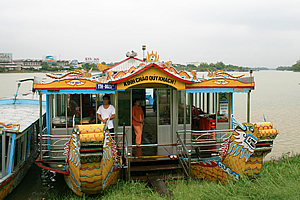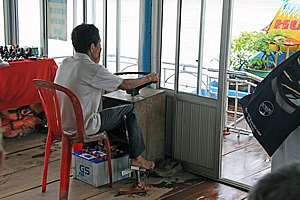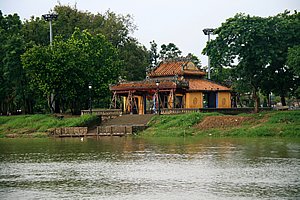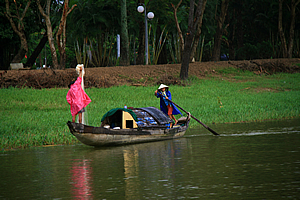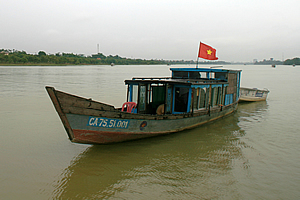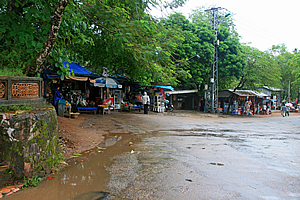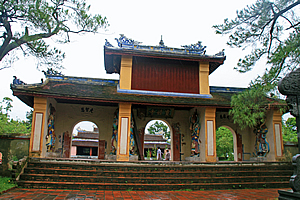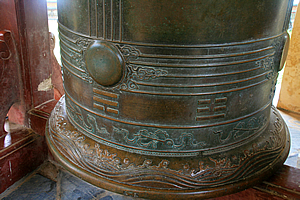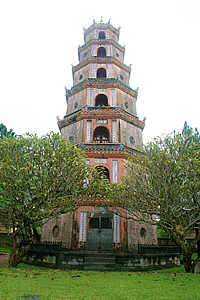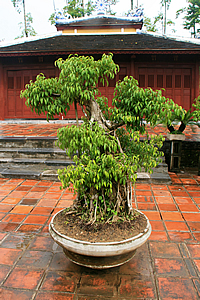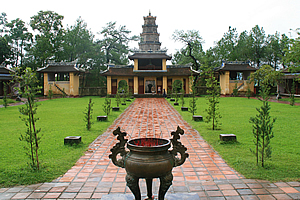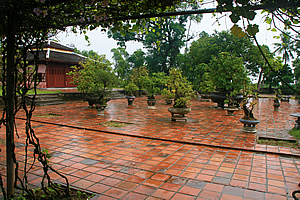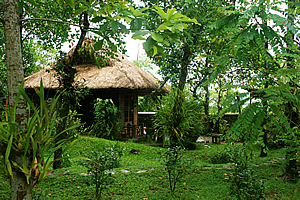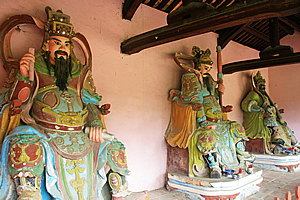--- Archive files ---
Home > Travels > Hue > 5 |
Buddhist Temple Retreat on the Perfume River
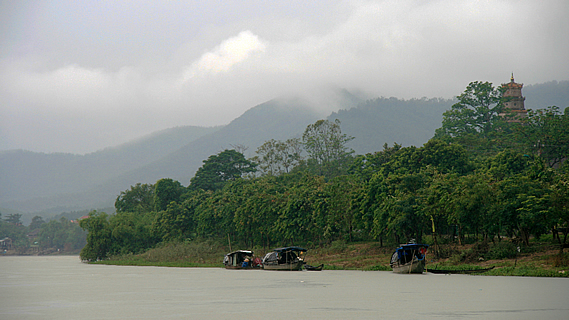
THE MORNING dawned overcast and drizzly without a sunrise. Following an afternoon yesterday of exploring royalty and an evening of dining like royalty it was time to explore the rest of the historical city of Hue.
Dragonboat |
The overnight rain had raised the level of the Perfume River a little higher than it had been yesterday, but it was still a fair way below bursting its banks. We walked past numerous dragon boats tied to the concrete riverbank until reaching the boat we will be travelling on today.
The hulls of the dragon boat were elaborately decorated with high bows shaped like dragon heads and decorated roofs. These were all painted in bright sky blue and yellow with some red highlights. The hull of each dragon boat had a potted tree growing in it. Inside the cabin on the other hand was very basic. It contained numerous warped floorboards nailed to the hulls (hopefully securely, but here you never know). On the floorboards were rows of cheap plastic chairs you are more likely to find in a kid’s picnic table. They were not attached to the floor at all. The walls of the boat were made from cheap plywood to about ninety centimetres above the floor, and above that dirty clear plastic windows and sliding doors in cheap aluminium framing. The ceiling was cheap plywood with a few florescent tubes hanging on it. The driver had a small steering wheel and wooden panel with some basic controls on the left hand side of the boat, and he too sat in a cheap plastic chair. There were two car batteries beside his seat
Our boat driver |
To the right of the driver, his wife was laying out a rug with some wares on it obviously with the intention of making a few sales. She had a captive market, so why not? This was a family who lived on the boat, and had packed up their bedding ready for us to sail on it today. This is how they live.
The boat pulled out of the jetty and began its trip up the river. The boat chugged along slowly whilst the lady came around attempting to sell stuff to us as we passed under the bridge. From memory none of us bought anything. I was sitting next to an open window, so I managed to photograph some of the passing boats, including a couple that were so heavily loaded with shingle they were barely above the waterline. I was worried the slight wake from our boat was going to sink them. Once water gets into a boat loaded like that, it would sink very fast under the weight of the shingle. I wondered how often that actually happened.
The emperor's port of the Imperial City |
I then went to the front of the boat out onto one of the bows to get a clean uninterrupted view of the river. We passed the imperial city which we had explored yesterday. From the river we could see the small pagoda ports that the kings of old had used. I stayed in the bow a little longer until heavy rain suddenly started falling. I quickly returned inside while the driver’s wife closed all the windows. Now we were without much view at all through the filthy windows as we continued to chug slowly up the river.
Boat people |
The squall cleared as we passed some pretty impressive houses beside the river. No doubt these had recently been flooded when Typhoon Ketsana hit a couple of weeks ago. We passed more boats, including several dragon boats carrying more tourists.
There were also plenty of privately owned boats. We overtook one old narrow boat that had a crudely built cabin. It was towing a dinghy behind it. The dinghy had a plastic chair sitting in the middle where the driver would sit on rather precariously I thought.
River boat |
We had been travelling about half an hour up the river when ahead of us was a bend on the right hand bank with a small rocky tree covered headland jutting out into the river. A tall pagoda towered above the trees. As we approached the end of the headland, we saw a stone staircase about five metres wide leading straight up the hill from the river towards the pagoda.
This was the Thien Mu Pagoda, the largest Buddhist pagoda in Hue. The boat driver moored the boat at the foot of the stairs allowing us to disembark and climb up towards the pagoda. The first few stairs were slippery with moss. We passed two yellow columns with Chinese writing on them. Fortunately after a couple of metres the stairs became easier to climb with the absence of moss. By now the rain had stopped falling and the hot sun was shining through a gap in the clouds.
Stalls below the temple |
The stairs temporarily stopped about half way up to cross a narrow road. The road had dirty rainwater flowing along the other side of it and the occasional motorbike tearing through. There were several stalls sheltered under the overhanging trees where people were standing forlorn under plastic sheeting waiting for someone brave enough to come and buy something off them. We carefully crossed the road in between the traffic speeding past. We then continued climbing up the stairs until we were a good twenty metres above the river. This was the start of what was once the king’s Buddhist retreat. The front of the retreat was quite narrow with the flat contour of the top of the hill, but it gradually widened as it swept further away from the river.
Temple entrance |
The path ended at the edge of a healthy green lawn where the tall pagoda dominated the scene immediately in front of us. It was surrounded by low trees. A small square pink bell tower appeared to either side of the main tower. The low trees concealed whatever lay beyond the pagoda, so at the time I guessed that this was it.
We entered one of the side towers as the sun suddenly disappeared, the humidity thickened and warm rain started falling again outside. A large metal bell, perhaps weighing a tonne or two and elaborately decorated with large Chinese characters filled the room. Danh explained the different rituals the bell was used for.
Giant bell |
Hurrying to avoid the rain, we then went around to the other side of the big tower to the other small tower where we saw a large stone turtle with a huge plaque behind it. The turtle represented the Earth. The designs on this were also very intricate, but it had been worn smooth by years of weathering and from people touching it over the centuries.
The rain was clearing, so we left the towers and walked a couple of metres through the trees until we saw more buildings. Directly ahead of us was a wide building with three arches, through which we could see a long courtyard and a bigger building on the other side of it.
Pagoda |
Huge bonsai tree |
We climbed the steps and passed through the middle arch of the building into a wide terracotta stone path with perfectly green lawn on either side of it. The path had small trees, perhaps only a year old, and small concrete cubes along either side. Directly ahead was a small brass pot standing in the middle of the path – a small cauldron on tall legs sitting on a square slab of concrete. It wasn’t big enough though to block people walking past. This was standing directly in front of the temple that now lay before us.
Urn in the temple |
The main temple contained a small golden Buddha in a glass box and numerous other statues and objects typically found in a Buddhist temple. There were two large wind chimes hanging in front of an altar on which sat a large bronze Buddha. Numerous ceramic pots and urns filled the place, some of which were very big. Several elaborate Chinese lanterns hung from the ceiling.
Behind the building through a door at the back was another courtyard, this time even bigger. The courtyard reminded me of a giant chess set. It was regularly divided up as a chess set was, but instead of chess pieces, it had huge bonsai trees in giant urns and pots. Some of these trees would have been hundreds of years old. I felt very small here in this garden of giant living chess pieces.
Courtyard of giant bonsai trees |
To the left we passed a couple of pink rendered brick buildings storing old vintage cars that had belonged to various royal members in recent decades. It was interesting that of all places, they decided to store them here in the back of a Buddhist retreat. We walked all the way to the back of the courtyard, following a walled pathway cut into the ground and paved. The low retaining walls on either side had pots of bonsai trees on either side. The tortured fig trees were writhing in suspended animation out of their pots. We had to take care as we walked over the slippery moss and lichen covered pavers.
Lush temple garden |
The path left the courtyard and passed a flat lawn of perfectly green grass. In the middle of the lawn was a small square pond surrounded by paving with lily pads growing in the stagnant water. On the other side at the very back of the retreat was a stone memorial. It had a single large pillar with a small cauldron on three legs in front of it. In front of that was a paved courtyard with an obelisk on either side containing Chinese characters.
We then followed a path down the other side of the small retreat through some lush gardens to our left, and the collection of bonsai trees to the right.
The three gods |
Upon returning to the first temple we walked back along the path towards the entrance to the pagoda area. To our left was an open building containing three large statues of gods sitting about three metres tall. They were each bearded with happy facial expressions, wearing a crown and elaborate robes. From the left, the first was the god of the heavens above, the second was the god of earth, where we dwell, and the third was a dark skinned god of the underworld. It was interesting that the god of the underworld was the dark one. If anything he should be the really pale one living underground and never seeing the sun.
Misty rain started falling again as we returned past the pagoda and down the stairs back to the boat. Once on board the pilot cast the dragonboat off to cross towards the other side of the river.
<< Previous | Next >> |
|
||
About this Page
|
||
|
|
|
Where is Walkabout Jeff? |
|
|
|
|
What is happening in Walkabout Jeff's hometown?
|
|
|
|
|
Who is Walkabout Jeff?Any normal person's idea of going out involves going to the local pub for a drink with a few mates. Walkabout Jeff isn't normal.
|
|
|
|
|
